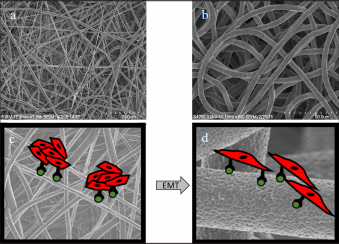Objective: Epithelial to Mesenchymal Transition (EMT) is an important phenomenon that is recently been recognized to play roles on prostate cancer metastasis through both epigenetic and biochemical signaling pathways. Using tissue engineering tools, we recreated a metastatic tumor niche to study the role of mir200 (a small RNA proven to reverse EMT processes) on extracellular matrix (ECM) fiber diameter guided prostate cancer cell EMT.
Material and methods: LNCaP cells were cultured on fibrous scaffolds for 48 hours. Role of fiber diameter (0.5 and 5 µm respectively) on cell morphology, viability, metabolic rate and EMT characteristics was assessed. Finally, the cells on fibers were transfected with a mir200 precursor to study the synergy between substrate topography and epigenetic signals on EMT of LNCaP prostate cancer cells.
Results: LNCaP cells formed cell clusters on fibers with 0.5 µm diameter while they form spindle shaped single cells possessing mesenchymal-like morphology when they were cultured on 5 µm diameter polymer fibers. The metabolic rate of cells growing on 5 µm fibers showed a substantial increase at 48 hours compared to flat topography or 0.5 µm- diameter fiber topography. LNCaP morphology is significantly different. Epithelial markers were stained positive on cells growing on small fibers while mesenchymal markers were positive on cells growing on large diameter fibers. mir200 did not alter the observed cell morphology on large diameter fibers.
Conclusion: Our results indicate that substrate topography is the governing signal for LNCaP prostate cancer cells to undergo EMT and mir200 did not reverse the EMT morphology on large diameter fibers.
Cite this article as: Özdemir T. The impact of mir200 on extracellular matrix topography-guided epithelial-to-mesenchymal transition of prostate cancer cells. Turk J Urol 2019; 45(Supp. 1): S30-S35.

.png)
.jpg)
.png)
.png)
